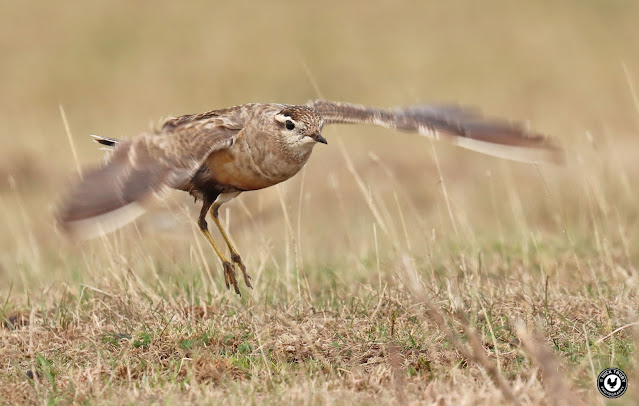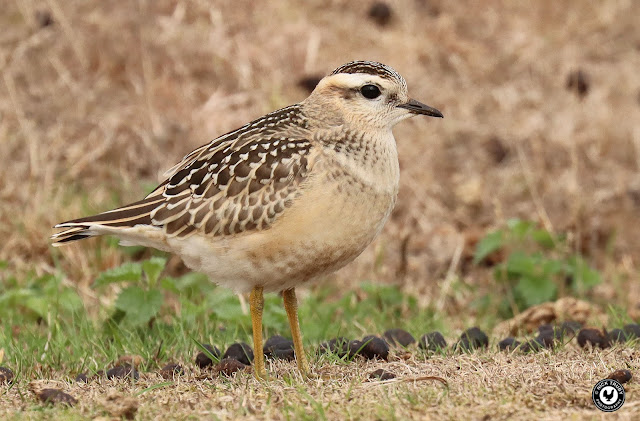I wanted to go up to Cleeve Common, on the top of Cleeve Hill and overlooking Cheltenham, the evening before but was deterred by the threat of some serious downpours. By parallel reasoning I decided that the forecast wet weather would likely ensure that the pair of Dotterel that had been found earlier in the day would stay overnight. Thanks to intrepid birders like my friend Simon, who went and looked for, and re-found, the Dotterel at first light the following morning that prophecy was proved correct. It's not often I get even a fifty-fifty choice right so I was feeling pretty smug when I shared the news with Mrs Caley. I finished work early and was home mid-afternoon, and it was straight in the car, even though there had been no updates on the birds status since lunchtime. We parked up at just before four o'clock and made the trek across the hill to the 'lone tree'. Between the carpark and the tree we met nobody so we didn't know whether the birds were still around or not but I felt confident since there was no reason for the birds to depart.
On reaching the tree, on the other side of the ridge we could finally see the few birders that were on site and fortunately they were all watching something, at fairly close range too, which had to be the pair of Dotterel. We tracked towards the spot making sure we kept beyond the line of sight. I expected to see the two birds doing what Dotterel do, that is running around capturing small invertebrates and the like, but I couldn't see anything. Maybe I'd come across a group of botanists but they don't tend to have massive long lenses attached to their cameras and I knew a couple of the chaps anyway. I scanned the ground knowing that the Dotterel would be close but it still took me while before I found the adult male of the pair secreted on a bare patch of ground around twenty metres from where I stood.
The travelling companion of the male Dotterel, a juvenile bird, was harder to spot as it lay on the grass in what constitutes the rough of the golf course that the birders, and us now, were unknowingly, at the time, stood and sat on. It was the juvenile bird that I really wanted to see. I hadn't seen a juvenile Dotterel for over twenty years since finding two in Cornwall while walking across a field on the way to twitch a Surf Scoter at Helston Loe Pool and thus I was keen to gain images of one. Most of our Dotterel sightings have been made in the early summer in Scotland, an undertaking that takes great effort because you have to be near or at the top of a mountain to see them, and when only adult birds are present. Like the male, the juvenile was snoozing.
We'd been there for maybe ten minutes during which time I'd had a chat with Lee, before the birds showed any sign of waking up. There are only so many images you can take of sleeping birds since there'd be no variation in the shots at all. Now the eyes of both birds were open and there was a prospect of getting some action.
A few minutes later and the birds were on their feet and looking lively. Lee had said that the birds would come really close when feeding and I wondered how much closer they could possibly get since they were no more than ten metres away anyway. That question was answered by the adult bird which instantly began walking towards us and soon halved the initial separation distance. The juvenile was slightly more reticent but was still far from shy. I know from experience of watching Dotterel on the Scottish high tops that if you sit still then they will probably come right up to you and so it was that these birds did. It highly likely that the juvenile bird at least had never seen people before so I guess that they've not come to mistrust us yet.
I was lucky to capture the moment when the adult bird did a little jump and fly. The motion blur of the wings caused by a low shutter speed owing to the overcast conditions added to the ambience. Mostly, even though Dotterel are powerful fliers and migrate great distances, the birds preferred to walk and run in their hunt for food, a habit inherent to all Plover species. Because the wind was blowing from behind us, both Dotterel were largely facing us too which helped me with gaining good and interesting images.
I lay prone on the grass, slightly mindful that I might be inviting some unwelcome guests in the shape of ticks which I understand are very prevalent this summer, and there are a lot of sheep on the common. I'm usually mad for ticks but much prefer the kind that get added to my year or life lists. Dotterel wouldn't be a year tick since we saw a lone female on Carn ban Mor in June. That sighting was a mere flyover and offered us scant reward for the effort we made to make it to the plateau for the second time that holiday. So to now watch the two birds at such close quarters was perfect compensation.
Our friends, Paul and Jules from Somerset arrived and we caught up with them as the Dotterel continued to perform. They brought a little bit of sun with them too and the common was bathed in rich light for a few minutes. This helped really bring the colours of the adult male to the fore. Bear in mind too that in Dotterel, the female is the more brightly coloured and better marked bird so this male was supposedly the dowdier of the species. As fine as he looked too! In contrast to normal practise amongst birds, it is the male Dotterel that are solely responsible for the upbringing of the young so there was a distinct possibility that the juvenile was one of his own offspring.
The adult male bird was moulting, a plumage state that I'd never seen before either. The transition would eventually lead to the adult looking much more aligned to the plumage exhibited by the juvenile. For now though it was the wing and mantle feathers that were being toned down for the colder months when all Dotterel regardless of sex revert to a mainly grey and buff plumage and males and females can't be distinguished by brightness of colour or by more pronounced markings.
Dotterel tend to choose places of higher altitude in which to breed and when migrating and Cleeve Hill certainly fits the bill as a decent staging ground for them. We have, however, seen a few in the spring in cultivated fields in flat pastoral country. Dotterel are rarely alone when they migrate, and can travel in groups or 'trips' when many of the species going together. Having said that the most I've ever seen together is a paltry four on migration! We did manage to see eight feeding on the same plateau in Scotland once so larger trips do obviously occur.
We'd been watching the Dotterel for almost forty-five minutes when, in response to a golf ball whizzing over head, they suddenly took off and flew to the top of the ridge behind us. I fired off shots at will at the fleeing birds without having time to focus correctly. By some minor miracle a few were almost sharp too. The golfer, who thankfully was extremely good at the game and not a hacker like I used to be, walked across to us and told us that we were all taking a huge risk by being in the middle of the fairway of the thirteenth hole. Until that point I hadn't even realised that it was a 'working' course. Now that I looked around me, I registered that of course it was a golf course! The Dotterel had captivated me so much that I'd been blind to the dangers. I've been hit by a golf ball before and it hurts. A lot!
Now we knew that we shouldn't be on the course, although usually the middle of a fairway is the safer place to be, well it was when I use to play the game, I decided that we'd seen enough and had had fine views already that wouldn't be bettered so we may as well get out of there. As we walked away one of the birders who had stayed on shouted in our direction, 'There's a harrier flying' and pointed past us back towards the radio masts and the carpark. I turned in time to see a bird of prey just disappearing over the ridge. I wouldn't have any idea what it was but the chap shouted again, 'Hen Harrier'. Rather flippantly I dismissed it because we'd already seen a couple of them this year so it wasn't needed for the year list and besides we'd essentially missed it anyway. I noticed afterwards that after photos of the bird had been posted online, presumably the other birder had been much sharper than I was, that there was some discussion of it being a juvenile Pallid Harrier, a species I've only seen twice before. I will be watching the ensuing discussion of its identity eagerly to see the outcome. If it is proven to be a Pallid Harrier then it may just find its way onto my year list, especially if I'm closing in on the Big Year target!



































No comments:
Post a Comment